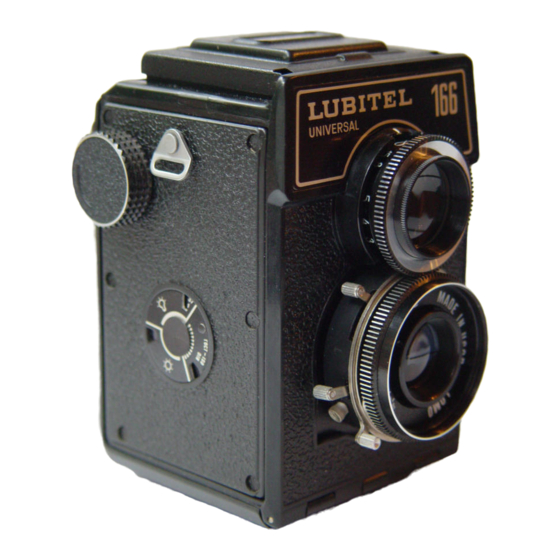
Advertisement
Lomo 166 Universal general instructions
Lubitel 166-Universal [Fig.1] is an up-to-date and simple in operation
camera intended for the widest range of photo amateurs. The camera
incorporates a coated lens, two viewfinders, diaphragm shutter with wide
range of speeds, self timer and flash synchronizer. It assures precise
focusing, operation with two picture sizes - 6 * 6 and 4.5 * 6cm, daylight
reloading and exterior shooting on tripod and hand-held shooting.
It is enough to raise a little the reflex viewfinder cover to see deep
between the light protective hoods a large and for any illumination distinct
clear image according to which it is easy to fit frame limits when the object
is already found or to find a new scene.
Image focusing is performed by slight rotation of a lens knurled mount.
Scales of distances, diaphragms and exposures and all the control units
are located to assure speed and convenient operation.
Frame counting is performed through the window according to values on
light protective paper of the film.
Due to reflex viewfinder it is possible to take pictures at high level holding
Advertisement
Table of Contents

Summary of Contents for LOMO Lubitel 166
- Page 1 Lomo 166 Universal general instructions Lubitel 166-Universal [Fig.1] is an up-to-date and simple in operation camera intended for the widest range of photo amateurs. The camera incorporates a coated lens, two viewfinders, diaphragm shutter with wide range of speeds, self timer and flash synchronizer. It assures precise focusing, operation with two picture sizes - 6 * 6 and 4.5 * 6cm, daylight...
- Page 2 the camera over the head as well as turning it horizontally at the right angle. Viewfinder lens has f/2.8, i.e. considerably higher than the photographic lens and thus the higher sensitivity to focusing. For taking pictures at eye level the frame viewfinder is used that is more convenient when there is experience in estimating distances by eye and in correct focusing according to distance scale.
- Page 3 To determine image limits the camera should be held at eye level, the object should be observed through the square window in the rear hood keeping the camera at the distance when the window edges coincide with those of the square opening in front frame. In this case the limits of the viewfinder field will be the image limits.
- Page 4 Before shooting it is necessary to cock the shutter rotating the cocking lever fully downward. Shutter is released with smooth pressing the release lever or the knob of the cable release, the camera is provided with the socket for it. With shutter set to B index it remains opened from the moment of pressing the release lever till its releasing.
- Page 5 Remember that with shutter set to B and release lever pressed it is impossible to cock the self-timer lever. Flash synchronizer is intended for matching the flashing moment with complete shutter opening. With electronic flash used the shutter may be set to any automatic exposure.
- Page 6 2.63 - 6 4.22 - 6.15 4.06 - 6.52 3.76 - 7.50 3.44 - 9.25 3.02 - 15.16 66.77 2.34 - 4 3.49 - 4.69 3.38 - 4.90 3.17 - 5.43 2.94 - 6.28 2.63 - 8.51 14.89 1.97 - 3 2.70 - 3.37 2.64 - 3.47 2.52 - 3.72...
- Page 8 At exposure scale every following value is two times preceding one. The diaphragm is f-numbered in such a manner that the pointer moving to a stop increases of decreases the amount of light for exposure two times. For instance the exposure time is 1/60 second at f/5.6 and if the lens has been stopped down to f/8 in other equivalent conditions the shutter should be set to 1/30 second.
- Page 9 film into the body receptacle between the spring and the body wall having pressed the flat spring with your finger. Unwind the end of the protective paper and on folding it down for about 10mm insert in the slot of the take-up spool. Then holding the spool with the film with your left finger and rotating the film rewinding knob wind 2 - 3 layers of the protective paper to the take-up spool.
- Page 10 Looking to the viewfinder determine the frame limits for 4.5 * 6 cm picture size, limiting marks (23) [Fig.5] are put down on the field lens] and with the focusing reach the required sharpness at the ground glass circle. If the object image that is required to get most sharp should be located at the picture edge turn the camera while focusing so that the object image was in the center and prior to the shutter release return the camera to the initial...
- Page 11 Pull the film at a picture length. To do that open the window cover plate and rotate the film rewinding knob (18) till the following figure appears in the window, then close the cover plate. Unloading the Camera After the last exposure has been made rewind the film protective paper onto the take-up spool.
- Page 12 Picture number 12 or 16 Photographic lens - coated three-element anastigmat T-22 Focal length 7.5 cm Relative aperture f/4.5 Viewfinder lens relative aperture f/2.8 1/250, 1/125, 1/60, 1/30, Automatic shutter speeds, s 1/15 With shutter speed set to B any manual-control shutter speeds are obtainable Diaphragm scale from 4.5 to 22...




Need help?
Do you have a question about the Lubitel 166 and is the answer not in the manual?
Questions and answers